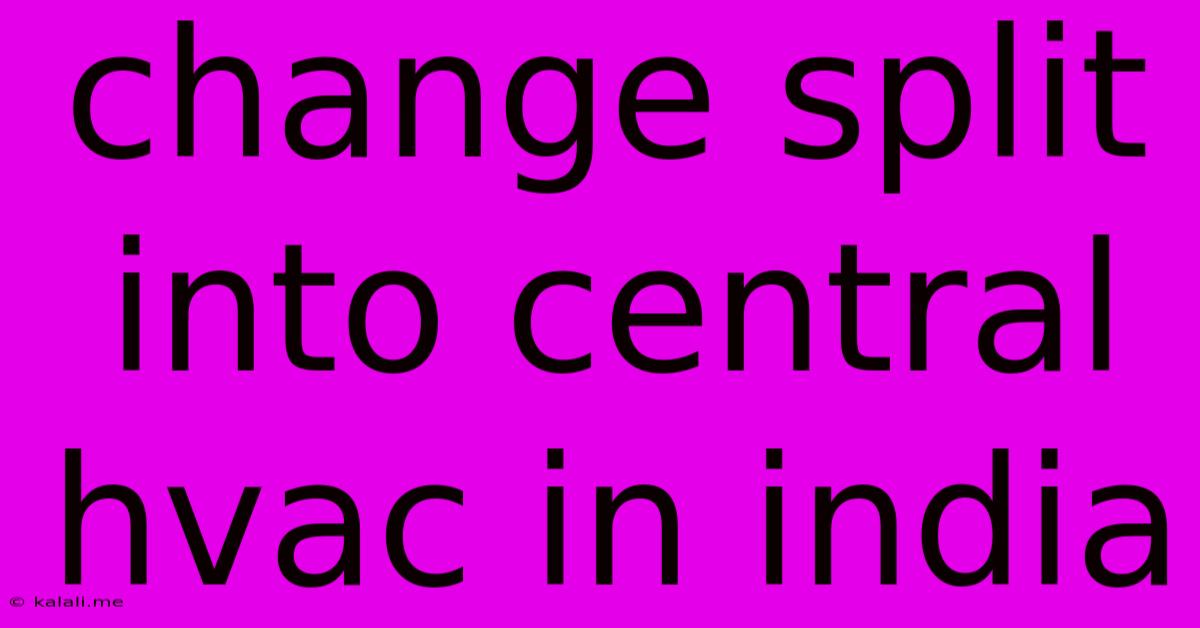Change Split Into Central Hvac In India
Kalali
Jun 07, 2025 · 4 min read

Table of Contents
From Split to Central HVAC in India: A Comprehensive Guide
Are you considering upgrading your home or business's cooling system from a split AC to a central HVAC system in India? This comprehensive guide explores the advantages, disadvantages, costs, and factors to consider when making this significant transition. The shift from individual split units to a central system offers a range of benefits, but also presents unique challenges within the Indian context. This article will help you make an informed decision.
Understanding the Differences: Split AC vs. Central HVAC
Before diving into the specifics of switching, let's clarify the key distinctions between split ACs and central HVAC systems. Split AC units are individual units, each cooling a single room. Central HVAC, on the other hand, utilizes a single system to control the climate throughout an entire building or home. This includes a central unit (often located outdoors) connected to a network of ducts that distribute conditioned air to various zones.
Advantages of Central HVAC in Indian Climates
India's diverse climate presents unique challenges for cooling. Central HVAC systems offer several advantages:
- Uniform Cooling: Unlike split ACs, central HVAC ensures consistent temperature throughout the entire space, eliminating hot and cold spots. This is especially beneficial in larger homes or commercial spaces.
- Improved Air Quality: Many central HVAC systems include air filters and purifiers, crucial in India's often polluted urban environments. This leads to better indoor air quality and improved respiratory health.
- Enhanced Energy Efficiency (Potentially): While initial investment is higher, a well-designed central HVAC system can be more energy-efficient in the long run than multiple split units, particularly in larger buildings. This is achieved through better zoning and potentially more efficient cooling technology.
- Zoning Capabilities: Modern central HVAC systems often allow for zoning, enabling you to control the temperature in different areas of your home independently. This is a significant benefit in larger Indian homes where different rooms may require varying temperatures.
- Aesthetic Appeal: Central HVAC eliminates the visual clutter of multiple outdoor and indoor split AC units, leading to a cleaner and more aesthetically pleasing environment.
Disadvantages and Considerations for India
Despite the advantages, switching to central HVAC in India involves some drawbacks:
- High Initial Investment: The upfront cost of installing a central HVAC system is significantly higher than installing multiple split AC units. This is a major consideration for many homeowners in India.
- Installation Complexity: Installing a central HVAC system requires professional expertise and careful planning, particularly in existing structures. This can be challenging to manage in densely populated areas of India.
- Maintenance and Repair: Central HVAC systems require regular maintenance and professional repairs, which can be costly. Finding reliable technicians with expertise in these systems might be a challenge depending on your location.
- Space Requirements: Central HVAC requires space for the outdoor unit, indoor unit, and ductwork. This can be a limiting factor in smaller homes or buildings.
- Power Requirements: Central HVAC systems have higher power requirements than individual split units, which is important to factor in with the Indian power grid's occasional inconsistencies.
Cost Factors and Considerations
The cost of switching to central HVAC in India varies significantly based on several factors:
- Size of the space: The larger the area to be cooled, the higher the cost.
- Type of HVAC system: Different systems (e.g., ductless mini-splits, traditional ducted systems) have varying costs.
- Building design: Existing buildings may require more extensive modifications to accommodate ductwork.
- Location: Labor and material costs vary across India.
- Brand and features: Higher-end systems with advanced features (e.g., smart thermostats, advanced air filtration) will be more expensive.
Making the Right Choice
Deciding between split ACs and central HVAC requires careful consideration of your individual needs and circumstances. Evaluate the advantages and disadvantages mentioned above, considering factors such as your budget, the size of your home or business, the climate in your area, and the long-term maintenance implications. Consulting with HVAC professionals is essential to get accurate cost estimates and personalized advice based on your specific requirements. Remember that while the initial investment is higher, the long-term benefits of better air quality, uniform cooling, and potential energy savings can make central HVAC a worthwhile investment for many Indian homeowners and businesses.
Latest Posts
Latest Posts
-
App To Manually Install Pkg File
Jun 07, 2025
-
Bike Seat Hammered And Stuck In Place
Jun 07, 2025
-
Things To Say When Someone Gets A Question Wrong
Jun 07, 2025
-
Sword Of Vengeance 5e Unarmed Attacks
Jun 07, 2025
-
Do Not Open At This Time Abbreviation
Jun 07, 2025
Related Post
Thank you for visiting our website which covers about Change Split Into Central Hvac In India . We hope the information provided has been useful to you. Feel free to contact us if you have any questions or need further assistance. See you next time and don't miss to bookmark.